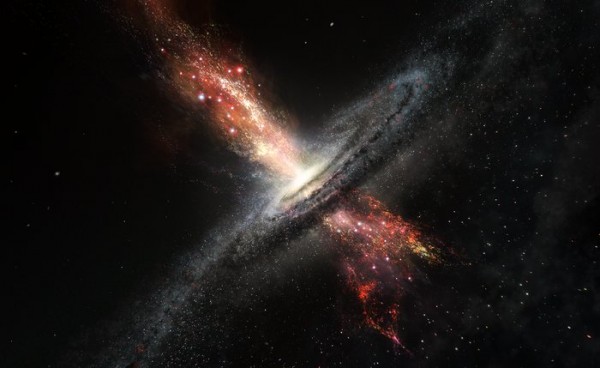By Ana Verayo, | April 06, 2017

Artist’s impression of a galaxy forming stars within powerful outflows of material blasted out from supermassive black holes at its core.
In one of the most massive scientific attempts, the world's most powerful telescopes are pointing to the skies to capture a photo of a black hole for the first time ever. More specifically, these telescopes will be observing the center of the Milky Way, which is home to our very own supermassive black hole.
Like Us on Facebook
Scientists will be aiming a total of 66 ALMA (Atacama Large Millimetre Array) radio telescope dishes and antennas in Chile for the next 10 days. They will be concentrating on this supermassive black hole located in the constellation Sagittarius A. Other telescopes include several at the South Pole that will also be observing the center of the Milky Way.
According to Heino Falcke of the Max Planck Institute for Radio Astronomy in Germany, this international project is known as the "Event Horizon". In order to view Sagittarius A, a powerful telescope which is 1,000 times better than the Hubble Space Telescope would make it possible to spot a supermassive black hole.
According to director of the Event Horizon Telescope, Shepard Doeleman, by concentrating all the radio dishes in the world on the exact moment, it will be possible to capture a photo of a supermassive black hole.
This colossal black hole that lies within Sagittarius A in the center of our galaxy is currently devouring cosmic clouds of dust and gases, including entire planets and stars that are all being reeled in by its powerful gravitational forces. Nothing can escape even light.
This is the reason why its event horizon is the only visible region within the black hole where light can be last seen before disappearing due to massive gravitational forces. Scientists say that technically, they will not be able to capture the black hole itself since it will be pitch black but the swirling hot stellar material around it.
-
Use of Coronavirus Pandemic Drones Raises Privacy Concerns: Drones Spread Fear, Local Officials Say

-
Coronavirus Hampers The Delivery Of Lockheed Martin F-35 Stealth Fighters For 2020

-
Instagram Speeds Up Plans to Add Account Memorialization Feature Due to COVID-19 Deaths

-
NASA: Perseverance Plans to Bring 'Mars Rock' to Earth in 2031

-
600 Dead And 3,000 In The Hospital as Iranians Believed Drinking High-Concentrations of Alcohol Can Cure The Coronavirus

-
600 Dead And 3,000 In The Hospital as Iranians Believed Drinking High-Concentrations of Alcohol Can Cure The Coronavirus

-
COVID-19: Doctors, Nurses Use Virtual Reality to Learn New Skills in Treating Coronavirus Patients







